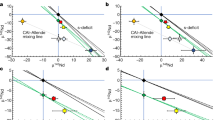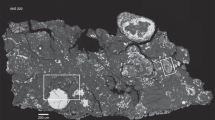Abstract
Compared with non-Antarctic falls, Antarctic meteorites include many of hitherto rare, unique or unknown type1, such as lunar and putative martian samples2–4. Attention has not previously been paid to the more common sorts of Antarctic meteorites and here we focus on the most frequently encountered, H5 chondrites. We find that compositional differences between Antarctic and non-Antarctic specimens of this class, especially those involving thermally sensitive trace and ultra-trace elements, are so substantial that it seems extremely doubtful that the two sample populations are derived from the same parent population. This implies that the contemporary falls (less than 200 years old) and the substantially older (on average, 300,000 years for Victoria Land) Antarctic meteorites either differ in genetic history or sample different extraterrestrial parent populations, or both.
This is a preview of subscription content, access via your institution
Access options
Subscribe to this journal
Receive 51 print issues and online access
$199.00 per year
only $3.90 per issue
Buy this article
- Purchase on Springer Link
- Instant access to full article PDF
Prices may be subject to local taxes which are calculated during checkout
Similar content being viewed by others
References
Bull, C. B. B. & Lipschutz, M. E. Lunar planet. Inst. (Houston) tech. Rep. 82–03 (1982).
Marvin, U. B. Geophys. Res. Lett. 10, 775 (1983).
Yanai, K., Kojima, H. & Katsushima, T. Meteoritics 19, 342–343 (1984).
Bogard, D. D., Nyquist, L. E. & Johnson, P. Geochim. cosmochim. Acta 48, 1723–1739 (1984).
Yanai, K. & Kojima, H. Proc. 9th Symp. Antarctic Meteorites (ed. Nagata, T.) 18–34 (National Institute of Polar Research, Tokyo, 1984).
Antartic Meteorite Working Group Antarctic Meteorite Newsl. NASA Johnson Space Center, Houston, (1978–85.
Scott, E. R. D., Proc. 9th Symp. Antarctic Meteorites (ed. Nagata, T.) 102–125 (National Institute of Polar Research, Tokyo, 1985).
Graham, A. L., Bevan, A. W. R. & Hutchison, R. Catalogue of Meteorites 4th edn (British Museum (Natural History), London, 1985).
Biswas, S., Ngo, H. T. & Lipschutz, M. E. Z. Naturforsch. 35 a, 191–196 (1980).
McSween, H. Y. Jr et al. Earth planet. Sci. Lett. 45, 275–284 (1979).
Biswas, S., Walsh, T. M., Ngo, H. T. & Lipschutz, M. E. Proc. 6th Symp. Antarctic Meteorites (ed. Nagata, T.) 221–228 (National Institute of Polar Research, Tokyo, 1981).
Verkouteren, R. M., Dennison, J. E. & Lipschutz, M. E. Geophys. Res. Lett. 10, 821–824 (1983).
Smith, M. R. et al. J. geophys. Res. 81 Suppl., B216–B630 (1984).
Mason, B. & Yanai, K. Proc. 8th Symp. Antarctic Meteorites (ed. Nagata, T.) 7–28 (National Institute of Polar Research, Tokyo, 1983).
Huston, T. J. & Lipschutz, M. E. Geochim. cosmochim. Acta 48, 1319–1329 (1984).
Neal, C. W., Dodd, R. T., Jarosewich, E. & Lipschutz, M. E. Geochim. cosmochim. Acta 45, 891–898 (1981).
Walsh, T. M. & Lipschutz, M. E. Geochim. cosmochim. Acta 46, 2491–2500 (1982).
Lingner, D. W., Huston, T. J. & Lipschutz, M. E. Meteoritics 19, 261–262 (1984).
Sears, D. W. G., Bakhtiar, N., Keck, B. D. & Weeks, K. S. Geochim. cosmochim. Acta 48, 2265–2272 (1984).
Sacks, L. Applied Statistics A Handbook of Techniques (transi. Regnarowich, Z.) (Springer, New York, 1982).
Kaczaral, P. W., Dennison, J. E., Lingner, D. W. & Lipschutz, M. E. Lunar planet. Sci. 16, 418–419 (1985).
Dixon, W. J. & Brown, M. B. (eds) BMDP Biomedical Computer Programs, P-Ser. (University of California Press, Berkeley, 1979).
Neter, J., Wasserman, W. & Whitmore, G. A. Appl. Statist., 370–376 (Allyn & Bacon, Boston, 1978).
Wetherill, G. W. Ann. Rev. Earth planet. Sci. 2, 303–331 (1974).
Verkouteren, R. M. & Lipschutz, M. E. Geochim. cosmochim. Acta 47, 1625–1633 (1983).
Jarosewich, E., Clarke, R. S. Jr. & Barrows, J. N. (eds.) preprint, US National Museum (1985).
Lipschutz, M. E., Biswas, S. & McSween, H. Y. Jr Geochim. cosmochim. Acta 47, 169–179 (1983).
Author information
Authors and Affiliations
Rights and permissions
About this article
Cite this article
Dennison, J., Lingner, D. & Lipschutz, M. Antarctic and non-Antarctic meteorites form different populations. Nature 319, 390–393 (1986). https://doi.org/10.1038/319390a0
Received:
Accepted:
Published:
Issue Date:
DOI: https://doi.org/10.1038/319390a0
This article is cited by
-
Meteoroid streams: Evidence from meteorites recovered on Earth
Earth, Moon, and Planets (1995)
-
Meteorites: Unexpected Antarctic chemistry
Nature (1986)
Comments
By submitting a comment you agree to abide by our Terms and Community Guidelines. If you find something abusive or that does not comply with our terms or guidelines please flag it as inappropriate.



